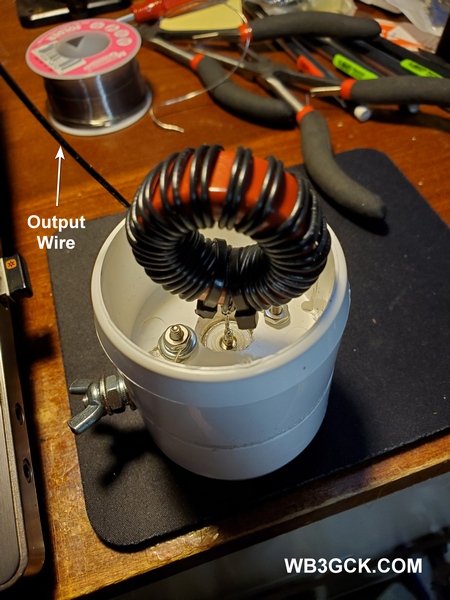One antenna I plan to try during my annual Outer Banks, North Carolina, vacation this summer requires a 4:1 unun. If the antenna works as hoped, it’ll be in place for the entire week. So, I need an unun that can stand up to the elements.
About a year ago, I built a 9:1 unun in a weather-resistant housing made from PVC pipe parts. I had some parts left over from that project, so I built a 4:1 unun version. The construction of this unun is like the last one, however, this one has a ground terminal.

I wouldn’t want to take this unun on a backpacking trip; it weighs in at a substantial 8.6 ounces. When I’m going to be operating from a location for an extended period, however, this should do the trick.
Parts
The parts for the housing are similar to the last one, but there are some additions for the ground connection.
- About 2.5 inches of 1.5-inch PVC pipe
- (1) 1.5-inch PVC end cap (slightly rounded top)
- (2) 1.5-inch PVC end caps with flat tops
- (1) SO-239 panel-mount connector (along with some #4 hardware for mounting)
- A 4:1 unun wound on a T130-2 toroid
- (2) #10-24×3/4″ stainless steel machine screw (along with some #10 flat washers, nuts, wing nuts, and lock washer)
The PVC end-caps with flat tops can be hard to find. If you search online for furniture-grade end caps, you might find some.
Construction
You can find plans for winding the unun here and other places on the Internet. The one I built for this project uses 19 bifilar windings of #24 solid hookup wire on the T130-2 toroid.
To start, you need to glue the two flat top end caps together. When dry, drill the holes to mount an SO-239 connector in the center.

For mechanical reasons, I added the #10-24 stainless steel screw for a ground terminal in the lower half of the connector housing. A short length of wire runs from the ground screw through a small hole and connects to one of the SO-239’s mounting screws. I installed another #10-24 screw in the slightly rounded end cap for the antenna connection.
The final assembly was straight forward. I soldered the toroid’s input wires to the center pin of the SO-239 connector. Then, I attached the toroid’s ground wire to one of the SO-239’s mounting screws.

Next, I inserted the PVC pipe section into the connector housing. I then installed a ring lug on the output wire. I left the output wire just long enough to make the connection to the output bolt in the rounded end cap. Before mounting the end cap to the PVC pipe, I added some pieces of foam around the toroid core to hold it in place. Then I press-fitted all the PVC parts together.
Testing in the Field
I tested the 4:1 unun in the field recently, and it performed as expected. I used it as part of a Rybakov vertical, with a 26-foot radiator supported by a Jackite pole, another 26-foot wire on the ground for a counterpoise, and 18 feet of RG-8x coax. My little Elecraft T1 tuner matched it with no problems on 40M, 30M, 20M and 17M, the bands covered by the rig I was using. Similar 4:1 ununs I have built worked well from 40M through 6M, so I’m confident this one will, too. While I was testing, I had a couple of nice CW rag chews on 40M and 30M.

Wrap-up
Like its 9:1 counterpart, this unun is probably a bit over-engineered. My weather-resistant 9:1 has served me well through several camping trips and two Field Days, so I expect this 4:1 version will do likewise. So, bring on that beach weather!
73, Craig WB3GCK














